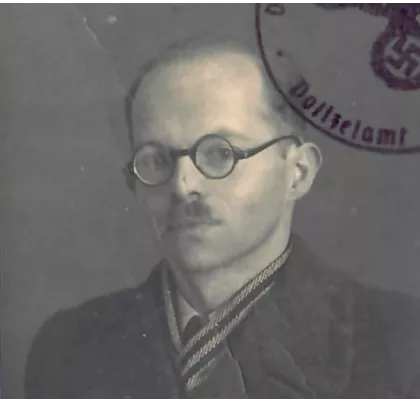Arno Bagainski (1924-?)
Sent to his death over a cigarette
- © OTFW
Arno Bagainski was born in Berlin on 30 November 1924. His parents Hermann Hirsch Bagainski and Helene Bagainski (née Ruschin) had two other children, Margot (born 1919) and Julius (born 1921), in addition to their youngest, Arno. His father Hermann was the owner of a legal advice and accounting office in Berlin.
Like his older brother - and presumably Margot - Arno attended the municipal primary school in Georgenkirchstraße in Berlin-Friedrichshain. In the late 1920s and early 1930s, the family suffered two strokes of ill fate:
In 1929, Hermann's leg was amputated up to the thigh as a result of an accident at work. As a result, he had to give up his business and became a welfare recipient, as he was no longer able to support his family. Just one day after her 35th birthday, in July 1930, Arno's mother Helene died. Arno was only five years old at the time.
In April 1932, Arno's father married Margarete Schach. Arno's half-siblings Erna (born in 1934) and Joachim (born in 1937) were the product of this second marriage.
In 1933, the gradual disenfranchisement and persecution of Jews began, which also affected the Bagainski family.
Arno and his brother Julius, for example, were forced to leave the municipal primary school in 1935. Julius was able to attend the Jewish school in Rykestraße until 1936 and Arno until 1939. Neither brother found an apprenticeship after leaving school. Between 1936 and 1938, Arno's siblings Julius and Margot completed further education courses in training camps, presumably in Groß Breesen (now Brzeźno near Trzebnica in Lower Silesia) and in Havelberg in Brandenburg. The purpose of these camps was to prepare young people for emigration. If Arno's older brother Julius actually made concrete plans to emigrate, they were not successful. Only Margot and her husband Heinrich, whom she had met in Havelberg, succeeded in emigrating to Palestine in 1939.
In the same year, Arno began an apprenticeship as a cook in the central kitchen of the Jewish community in Berlin. However, in autumn 1941 after repeatedly being threatened on his way to work because of the "Jewish star" attached to his clothing, he decided to quit his job. From October 1941 at the latest, the then 16-year-old Arno, just like his father Hermann, his stepmother Margarete and his brother Julius, was sent into forced labour in Berlin companies.
- © Arolsen Archives, collection 1.2.4.1, docID 12648148
Following systematic disenfranchisement, the Bagainski family was deported: Arno's brother Julius was deported as part of the first wave of deportations from Berlin on 18 October 1941 via Grunewald station to the Litzmannstadt ghetto (Łódź). Six months later, on 7 May 1942, he was deported to the Kulmhof (Chełmno) extermination camp. He was presumably murdered there shortly after arriving. His family members in Berlin probably received no information about Julius' fate.
Also in May 1942, Arno's father Hermann was arrested as part of the arbitrary retaliations following the arson attack on the Nazi propaganda exhibition "Das Sowjet-Paradies" ("The Soviet Paradise") in Berlin and taken to Sachsenhausen. There, on the morning of 28 May, 250 of the 500 people arrested were shot, including Arno's father Hermann Bagainski.
- © Arolsen Archives, collection 1.2.4.1, docID 127187766
The remaining family members received their deportation orders shortly afterwards. Arno, his stepmother Margarete and his underage half-siblings Erna and Joachim were taken to the detention centre at Große Hamburger Straße 26. From there, they were deported to the Theresienstadt ghetto in early June 1942 on a special transport intended exclusively for relatives of those who had been shot.
Arno Bagainski volunteered for a labour unit in the Theresienstadt ghetto and, presumably after other assignments, was sent to the so-called Zossen labour detail in Wulkow in March 1944.
In 1944, he was deported as a punishment, together with other prisoners, for possessing cigarettes. The camp commandant Franz Stuschka repeatedly sent individuals to Sachsenhausen or the Gestapo prison in the Small Fortress in the Theresienstadt ghetto as a form of more severe punishment. These transfers were usually a death sentence for the deportees. This was probably also the case for Arno Bagainski: at the end of September 1944, Margarete Bagainski, who was interned in the Theresienstadt ghetto, received a letter from her stepson Arno from the detention centre in the former pathology department of the Jewish Hospital in Wedding, Berlin. This letter was the last known sign of life from Arno Bagainski, who was 19 years old at the time.
Margarete Bagainski and her children Erna and Joachim were liberated by the Red Army in Theresienstadt in May 1945. After liberation, they went to Switzerland and later lived in Israel in a kibbutz with Margot (Miriam Timnah, deceased 2016) and her husband.
Indra Hemmerling: Biografie Arno Bagainski, in: Stolpersteine in Berlin.
http://danielabraham.net/tree/related/dora/, accessed on 21.08.23

